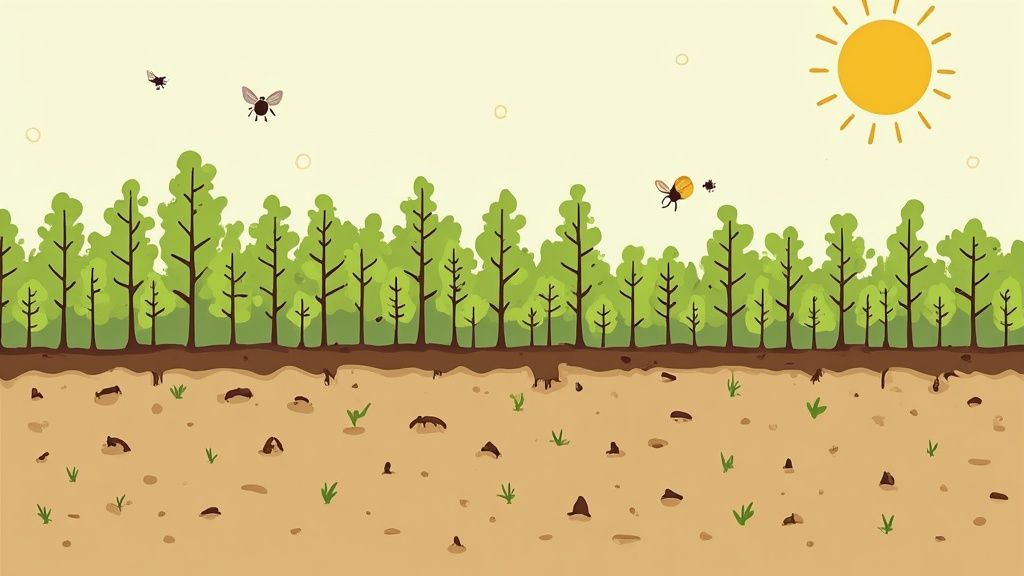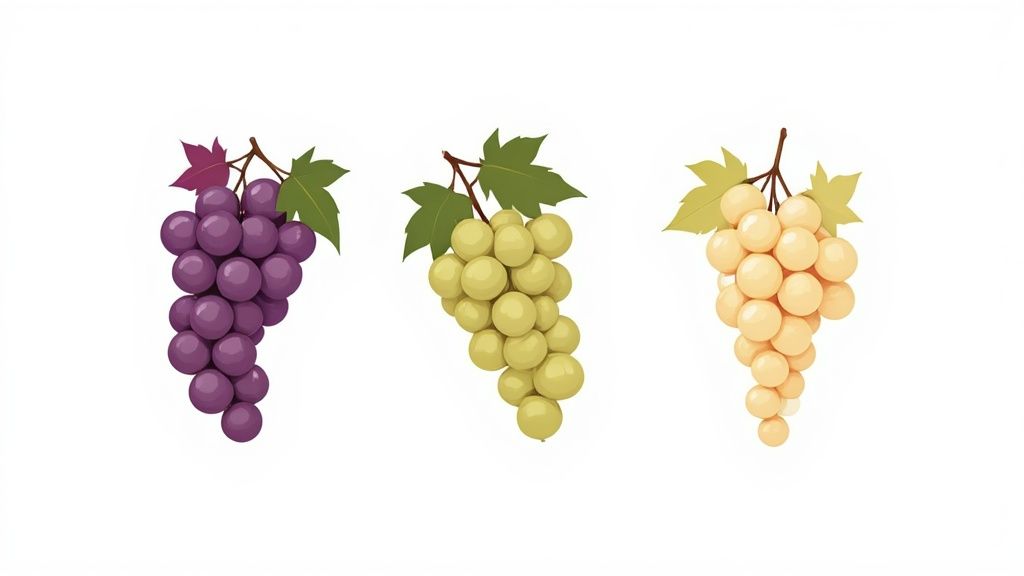When you hear the term 'organic wine' in Australia, think of it as a promise—a commitment to farming that works with nature, not against it. The result is a bottle of wine that’s a pure, unadulterated expression of the land it came from. It all starts with a focus on building healthy, living soil, steering clear of synthetic chemicals to create wines that are vibrant, authentic, and tell a story.
What Makes Australian Wine Truly Organic?

To get your head around what makes an Australian wine truly organic, picture the vineyard as a bustling, self-sufficient ecosystem. Forget sterile fields doused in chemicals. An organic vineyard is humming with life—beneficial insects darting about, cover crops growing between the vine rows, and rich soil teeming with microbes. That’s the heart of it.
The journey to an organic wine doesn’t start with the grapes; it starts with the dirt beneath them. Organic growers are obsessed with nurturing the soil naturally, using compost and cover crops to build fertility. This healthy foundation creates stronger, more resilient vines that can naturally fend off pests and diseases, without needing a chemical arsenal of synthetic pesticides, herbicides, or fertilisers.
The essence of organic winemaking is proactive, not reactive. It's about cultivating a balanced environment where vines can thrive on their own terms, leading to grapes that are a genuine reflection of their place, or terroir.
This hands-off philosophy carries through from the vineyard all the way into the winery.
From Vine to Bottle
Once those beautiful, organically grown grapes are picked, the low-intervention approach continues. While a conventional winemaker might reach for a toolbox of additives to tweak flavour, colour, and texture, organic winemaking is far more restrained. The goal is simple: let the quality of the fruit do the talking.
You’ll see this in a few key practices in the winery:
- Using native yeasts: Many organic winemakers let the wild yeasts that live on the grape skins handle fermentation. This adds layers of complexity and a unique character you just can't replicate.
- Minimal additions: The use of additives is strictly limited. While a small amount of sulphur dioxide (a preservative) is often allowed, the levels are typically way lower than in conventional wines.
- Gentle handling: Things like heavy fining and filtration are often skipped or dialled right back to preserve the wine’s natural texture and flavour profile.
More Than Just a Trend
The growing love for organic wines in Australia isn’t just some passing fad; it’s a return to traditional, sustainable farming that makes sense. It’s an honest approach that connects you, the drinker, directly to the land where the grapes were grown.
By choosing organic, you’re backing a style of agriculture that looks after our environment for the long haul. And the payoff? A more authentic, expressive glass of wine. It’s a beautiful cycle where healthy soil leads to healthy vines, which in turn produce vibrant, top-quality grapes.
Understanding Australian Organic Wine Certifications

When you see the word "organic" on a wine label, how do you know it's the real deal? In Australia, that confidence comes from a rigorous and legally protected certification system. Think of it less as a marketing sticker and more like a passport, stamped with proof of its journey and its adherence to a strict set of national rules.
This system is what separates a casual claim from a proven commitment. Any winery can say they use "organic practices," but only those who have gone through a demanding, independent verification process can legally label their wine as 'Certified Organic'. That distinction is your most reliable guide to authenticity.
Logos from official bodies like Australian Certified Organic (ACO) are symbols of trust. They’re a guarantee that the wine in your hand has met some of the world's toughest organic standards, all backed by the Australian government.
The Journey to Certification
Becoming certified isn't an overnight affair; it’s a long-term commitment that truly tests a grower's dedication. Before a winery can even think about certification, its vineyard must go through a mandatory conversion period, which typically lasts for three years.
During this entire time, the land must be farmed according to strict organic principles, completely free from any synthetic chemical inputs. This transition phase ensures that any residual pesticides, herbicides, and fertilisers are flushed from the soil, creating a genuinely clean foundation for the vines. Only after this period is successfully completed can a vineyard start producing grapes that qualify as certified organic.
The three-year conversion is a fundamental step. It’s like detoxing the land, allowing the soil to heal and rebuild its natural vitality, which is essential for producing grapes that genuinely express their terroir.
And the scrutiny doesn't stop there. Once certified, producers are subject to annual, independent audits to make sure they're sticking to the rules.
Key Pillars of Australian Organic Certification
So, what does it actually take to get that stamp of approval? The requirements are extensive and cover every single step, from the soil to the bottle. An auditor's checklist is long, but here’s a look at the core requirements wineries must meet.
Australian Organic Wine Certification Key Requirements
This table summarises the essential standards Australian wineries must meet to achieve and maintain their organic certification, ensuring transparency and trust for consumers.
| Requirement | Description | Why It Matters for Consumers |
|---|---|---|
| No Synthetic Chemicals | A complete ban on synthetic pesticides, herbicides, fungicides, and artificial fertilisers in the vineyard. | Guarantees the wine is free from synthetic chemical residues and supports healthier farming ecosystems. |
| Soil and Water Health | Wineries must proactively build soil fertility naturally through practices like composting and planting cover crops, alongside responsible water management. | Healthy, living soil produces more vibrant, flavourful grapes and promotes sustainable land use for future generations. |
| Biodiversity Promotion | Encourages a balanced ecosystem with beneficial insects and native plants to create a resilient, self-regulating environment. | Reduces the need for pest control and creates a more natural, harmonious vineyard environment. |
| Strict Winery Practices | Additives in the winery are heavily restricted. For example, allowable levels of sulphur dioxide (preservatives) are significantly lower than in conventional wines. | Leads to a more natural expression of the grape and terroir, with fewer additives in the final product. |
| Full Traceability | Meticulous record-keeping is mandatory, allowing every bottle to be traced back to the specific vineyard plot where its grapes were grown. | Provides ultimate transparency and accountability, ensuring the integrity of the organic claim from grape to glass. |
These pillars ensure that every certified bottle meets a consistent, high-quality standard that you can rely on.
Why Certification Is Your Best Guarantee
This robust framework provides a clear point of difference in a crowded market. While interest in organic wine is growing, certified organic vineyards still only make up just over 1% of Australia's total vineyard area. This niche status is a direct result of the incredibly high standards required.
Australia's organic wine sector is valued at around AUD 158 million and is expanding every year, a growth driven by consumer trust in these stringent certifications. To explore this further, you might find it helpful to read about why organic certifications matter.
For those interested in the subtle but important differences between various sustainable approaches, you can dive deeper in our guide explaining organic, biodynamic, and natural wine.
Ultimately, the demanding process—from the three-year land conversion and annual audits to soil testing and complete traceability—ensures that when you choose a certified Australian organic wine, you are getting a product of proven integrity.
The Real Benefits of Choosing Organic Wine
So, what are the actual rewards of reaching for a bottle of organic wine? It goes far deeper than a logo on a label. This is a choice that ripples outwards, benefiting the planet, your own wellbeing, and most importantly, the taste of the wine in your glass.
Choosing organic wines in Australia is a direct vote for a healthier planet. Think about it: conventional vineyards can often operate like monocultures, heavily reliant on a constant cycle of synthetic chemicals. Organic farming flips that script completely, treating the vineyard as a living, breathing ecosystem.
The whole approach is about building rich, healthy soil using natural methods like composting and planting cover crops between the vine rows. This isn't just good for the earth—healthier soil holds water far more efficiently, a massive advantage in Australia's often-dry climate. It also cuts out the need for artificial fertilisers.
By saying no to synthetic pesticides and herbicides, organic wineries stop harmful chemical runoff from polluting our precious waterways and ecosystems. This protects native plants and animals, creating a more balanced environment.
A Healthier Glass for a Healthier You
The good stuff doesn't stop at the vineyard gate; it extends right into your glass. When you pick a certified organic wine, you're choosing a drink made from grapes grown without any synthetic pesticides, herbicides, or fungicides. That means you can feel confident there are no unwanted chemical residues finding their way into your wine.
On top of that, many people find organic wines are simply gentler on their system. This is often linked to the lower levels of sulphur dioxide (SO₂), a common preservative in winemaking. While not every organic wine is totally preservative-free, the certification standards cap the allowable amount at levels significantly lower than conventional wines.
For anyone sensitive to sulphites, this reduction can be a game-changer. It can mean fewer of those tell-tale reactions like headaches or stuffiness, letting you simply enjoy wine in its most natural, unadulterated form.
This "less is more" philosophy is central to organic winemaking. If you want to dive deeper into the world of additives, you'll find everything you need in our detailed guide on preservative-free wine. The belief is simple: great wine is grown in the vineyard, not manufactured with a long list of adjustments in the winery.
The Ultimate Expression of Terroir and Taste
For any true wine lover, perhaps the most compelling reason to go organic is the flavour. Organic practices allow a wine to express its unique sense of place, or terroir, with stunning clarity. When vines are nourished by vibrant, microbially rich soil—free from a chemical shield—their roots dig deeper, drawing up a complex array of minerals and nutrients from the earth.
This direct connection to the land creates grapes with more concentrated and nuanced flavours. The final wines often have a vibrancy, character, and complexity that can sometimes be muted in their conventional counterparts.
- Purer Fruit Expression: Without the interference of synthetic chemicals, the true personality of the grape variety shines through with more intensity and purity.
- Greater Complexity: Organic winemakers often use native yeasts found naturally on the grapes, which can introduce unique and layered aromas and textures you just don't get from commercial yeast strains.
- A Story in Every Bottle: An organic wine tells the story of its vintage and its specific patch of earth. You’re not just tasting grapes; you’re tasting the sunshine, the soil, and the unique ecosystem of that vineyard.
Ultimately, the benefits form a perfect circle. Sustainable farming creates a healthier environment, which produces higher-quality, more expressive grapes. These grapes, handled with minimal intervention, result in a cleaner, more authentic wine that simply tastes better. It’s a win for the planet, a win for your wellbeing, and a definite win for your palate.
Exploring Australia's Top Organic Wine Regions
Australia's massive, diverse landscapes are the perfect stage for some of the world's most exciting organic wines. The real secret isn't just what happens in the winery; it's the land itself. Unique combinations of climate, soil, and geography create the ideal playground for organic viticulture to truly shine.
From the sun-drenched hills of South Australia to the salty breezes of the west coast, certain regions have become natural hotspots for the organic movement. These areas often get a helping hand from Mother Nature with drier climates, which automatically lower the risk of mildew and other diseases that can give vignerons a headache. It's a crucial head start, letting them farm without reaching for synthetic sprays.
Let's take a tour through the heartlands of organic wines in Australia.
South Australia: The Organic Powerhouse
When you talk about organic wine in Australia, South Australia is the undeniable engine room. It’s home to some of the country's oldest vines and most iconic names, and it boasts a powerful trio of regions leading the charge.
- McLaren Vale: Often called the epicentre of the organic and biodynamic scene, McLaren Vale’s warm, dry Mediterranean climate is a perfect match for this style of farming. The coastal influence brings in cooling afternoon breezes that lock in the acidity while the sun works its magic on ripening. It's a true leader in sustainable practices.
- Barossa Valley: Famous for its big, bold Shiraz, the Barossa’s warm climate and ancient soils are also wonderfully suited to organic viticulture. With low rainfall and humidity, disease pressure is almost a non-issue, allowing pioneering producers to focus on building healthy soils and crafting wines with incredible depth.
- Clare Valley: This region’s higher altitude and cool nights offer a different but equally fantastic environment. Known for world-class Riesling, the Clare Valley’s continental climate helps organic growers produce wines with vibrant intensity and exceptional balance.
These South Australian regions have become a magnet for winemakers who want to let their unique patch of dirt speak for itself, with as little interference as possible. For a deeper look into the area, check out our guide on https://mclarenvalecellars.com/blogs/articles/exploring-the-organic-winemaking-landscape-of-mclaren-vale.
Western Australia: Margaret River's Coastal Influence
Heading west, Margaret River stands out as another key player in the premium organic wine game. Its maritime climate, shaped by the Indian and Southern Oceans, creates a long, gentle, and remarkably consistent growing season.
This unique coastal environment is perfect for growing pristine organic Cabernet Sauvignon and Chardonnay. The clean air and ancient, free-draining soils provide a pure foundation for vines to thrive naturally. While the region is already famous for its conventional wines, more and more producers are going organic to create wines that taste even more like their stunning coastal home.
A region's climate is its greatest asset in organic farming. Drier, sunnier conditions are nature's own defence against common vineyard diseases, making places like the Barossa and McLaren Vale natural homes for organic viticulture.
Victoria: Pioneering In Cooler Climates
While warmer regions have a natural advantage, don't think for a second that dedicated organic producers aren't making incredible wines in Victoria's cooler climates. Places like the Yarra Valley and Mornington Peninsula are proving that with meticulous care and attention, organic principles can succeed anywhere.
These areas face more challenges, sure, but the winemakers here are deeply passionate about sustainability. They’re crafting elegant, nuanced organic wines—especially Pinot Noir and Chardonnay—that show a different, more delicate side of Australian organic production. If you're thinking of visiting these picturesque spots, it helps to plan your journey through Australia to really soak in the diverse landscapes.
Even though only about 7% of Australian wineries are currently certified organic or biodynamic, the sector is growing much faster than conventional wine. This boom is being driven by drinkers like you, who value sustainability and are actively looking for wines made without synthetic chemicals. As this demand keeps growing, some industry forecasts predict the Aussie organic wine market could triple by 2030, setting these key regions up for even bigger things on the world stage.
Must-Try Organic Grape Varieties from Australia

While the principles behind organic farming set the stage, it's the grapes themselves that bring the magic to the bottle. Australia’s incredibly diverse climates mean a whole host of grapes can flourish under organic care, each expressing its unique character with a newfound vibrancy.
Think of organic viticulture as turning up the volume on a grape's natural personality.
From bold, spicy reds to crisp, aromatic whites, certain varieties have become the undisputed stars of the Aussie organic wine scene. These grapes don't just survive in an organic system; they absolutely thrive, producing wines with incredible purity, depth, and a real sense of place. Let's dive into the iconic grapes that should be on every organic wine lover's list.
Shiraz: The Bold and Bountiful Red
Shiraz is Australia’s signature grape, and under organic farming, it becomes even more expressive. Famous for its powerful structure and rich flavours, organic Shiraz often shows off a brighter, more lively fruit profile. It's all thanks to those healthy, living soils that allow the vines to produce grapes with a beautiful balance of ripeness and natural acidity.
You can still expect those classic notes of blackberry, plum, and black pepper, but with an added layer of complexity. Think hints of dark chocolate, licorice, and a savoury, earthy undertone that speaks directly of its chemical-free home.
- Flavour Profile: Full-bodied with notes of dark berries, spice, and a savoury finish.
- Best Regions: McLaren Vale and the Barossa Valley are the heartlands for powerful, world-class organic Shiraz.
- Food Pairing: The perfect match for a classic Aussie BBQ, slow-cooked lamb shanks, or a rich beef stew.
The love for red varieties like Shiraz is clear across the market. Recent data shows that the red organic wine segment accounts for a whopping 61.27% of total organic wine revenue in Australia. This impressive market share is part of a sector that generated USD 158 million in 2023 and is projected to nearly double by 2030, showing just how much Aussies love a good organic red. You can learn more about Australia's organic wine market growth and its bright future.
Chardonnay: The Versatile White
Forget the heavily oaked Chardonnays of the past. Organic Chardonnay from Australia is all about elegance, purity, and texture. By ditching the synthetic inputs, winemakers can capture the grape’s true character, resulting in wines that range from crisp and unoaked to complex and barrel-fermented.
Organic practices often lead to wines with a distinct mineral streak and heightened aromatics. You'll find bright notes of green apple, citrus, and white peach, often with a subtle, creamy texture from minimal intervention techniques like using native yeasts for fermentation.
- Flavour Profile: Medium to full-bodied with flavours of stone fruit, citrus, and a crisp, mineral finish.
- Best Regions: Cooler climate areas like Margaret River and the Adelaide Hills produce stunningly elegant organic Chardonnay.
- Food Pairing: Pairs beautifully with roast chicken, creamy pasta dishes, or grilled seafood.
Sauvignon Blanc: The Aromatic Superstar
Australian organic Sauvignon Blanc is a world away from its overseas cousins. It’s known for its intense aromatics and zesty freshness—qualities that are only amplified by organic farming. Healthier vines produce grapes bursting with flavour, leading to wines that are lively and incredibly refreshing.
Expect an explosion of tropical fruit aromas—passionfruit, guava, and pineapple—all balanced by a zesty citrus backbone and a clean, crisp finish. It’s the quintessential Australian white for a warm day.
Choosing an organic Sauvignon Blanc often means you're getting a wine with a purer, more pronounced fruit character. The absence of synthetic chemicals allows the grape's natural aromatics to take centre stage without any distractions.
With its vibrant personality and food-friendly nature, it’s no wonder this variety is a favourite among those seeking expressive organic wines in Australia.
So, you’re ready to explore the brilliant world of Australian organic wine? That’s fantastic. Finding a bottle you truly love is a fun journey, and it's much simpler than you might think. With a few pointers, you’ll be navigating wine labels like a pro and making sure every glass you pour is absolutely perfect.
First things first, where do you look? Your local independent bottle shop is always a great place to start. The people working there are usually wine lovers themselves and can give you some cracking recommendations for organic wines Australia is producing. For a truly special experience, nothing beats visiting a winery's cellar door. You get to taste the wine right at the source and hear the stories from the very people who crafted it.
And of course, there are some brilliant curated online stores out there. They offer a massive selection and the pure convenience of exploring wines from all over the country without leaving your couch.
Decoding the Wine Label
Staring at a wall of wine can feel a bit daunting, but learning to read the label is your secret weapon. The most important thing to hunt for is an official certification logo.
- Spot the Symbol of Trust: Keep an eye out for logos from certifying bodies like Australian Certified Organic (ACO) or NASAA Certified Organic (NCO). This little symbol is your guarantee that the wine has met super strict national standards, from the vineyard all the way to the bottle.
- Understand Key Terms: You might see phrases like "preservative-free" or "no added sulphur." While many organic wines do have lower sulphur levels, these terms are not the same as being certified organic. Proper certification guarantees the entire farming and winemaking process is organic from top to bottom.
Think of the certification logo as a passport. It verifies the wine's journey and proves its organic integrity, giving you complete confidence in what you're buying.
By focusing on these official marks, you can easily tell the difference between a genuinely certified organic wine and one that just makes vague claims about using "organic methods."
Storing and Serving Your Organic Wine
Once you've got your new bottle home, a little bit of care will make sure it tastes exactly how the winemaker wanted it to. Organic wines, especially those with very low sulphur, can be a touch more sensitive to their surroundings.
The best practice is to store all your wine—red, white, or sparkling—in a cool, dark place with a steady temperature. Keep it away from direct sunlight and vibrations. A cellar or wine fridge is ideal, but a cool, dark cupboard works a treat too.
When you’re ready to pop the cork, serving temperature is key to unlocking all those beautiful aromas and flavours. A good rule of thumb is to chill light-bodied whites and rosés for a couple of hours. For a full-bodied red, don't be afraid to pop it in the fridge for 15-20 minutes before serving. This little trick can soften the alcohol and really make the fruit flavours sing, giving you a much more balanced and delicious tasting experience.
Cheers to your organic wine adventure
Your Questions About Organic Wine, Answered
Diving into the world of organic wine can spark a few questions. We get it. Here are some clear, straightforward answers to the queries we hear most often, so you can feel completely confident in your next bottle.
Does Organic Wine Taste Different?
Yes, it often does—and for the better. Organic wines are often praised for tasting more alive, offering a pure expression of the grape and the land it came from. Because the vines are grown in healthier, more biodiverse soil without synthetic chemicals, the flavours can feel more concentrated and vibrant, giving the wine a character that truly speaks of its home.
Is Organic Wine More Expensive?
Sometimes, yes, you might notice a slightly higher price tag. There’s a good reason for this. Organic farming is far more hands-on. Managing weeds and pests naturally requires more manual labour in the vineyard, and the official certification process itself involves costs for audits and compliance.
Think of it less as an expense and more as an investment. That small premium supports sustainable agriculture, a healthier planet, and a more authentic, higher-quality wine that reflects the true cost of mindful farming.
Are All Organic Wines Preservative-Free?
Not always. While Australian certified organic standards are very strict about limiting sulphur dioxide (SO₂), most organic wines will contain a small amount to keep them stable and fresh. The key difference is that the permitted levels are significantly lower than in conventional wines.
If you’re looking for a completely sulphur-free option, keep an eye out for labels that specifically state "preservative-free" or "no added sulphur."
How Do I Know if a Wine is Genuinely Organic?
The easiest and most reliable way is to look for an official certification logo on the label. In Australia, the two you’ll see most often are from Australian Certified Organic (ACO) and NASAA Certified Organic (NCO).
These logos are your guarantee. They confirm the wine has met rigorous national standards every step of the way—from the vineyard to the final bottling—ensuring its integrity and authenticity.
At McLaren Vale Cellars, we make it easy to explore the best organic wines from one of Australia's most celebrated regions. Discover authentic, flavourful wines and enjoy free Australia-wide delivery on orders over $100. Shop our organic wine collection today.




Comments (0)
There are no comments for this article. Be the first one to leave a message!